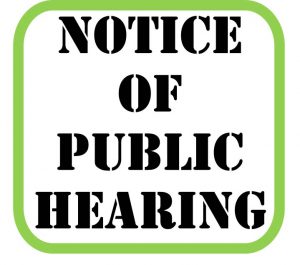Posts by jim
Fresh from the Vault: Open Records Act Results from the Dallas Office of Environmental Quality
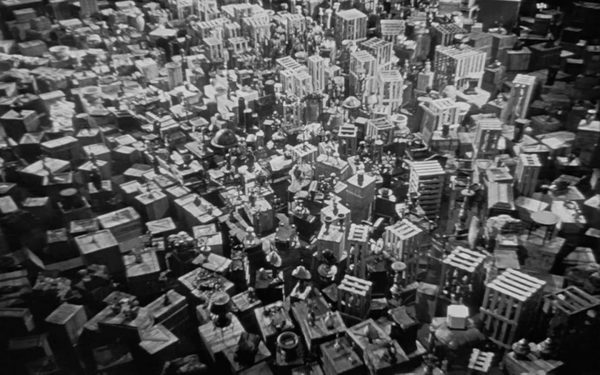
Last month we requested the City of Dallas’ Office of Environmental Quality files concerning air quality monitoring going back a few years. We wanted to know more about how City staff chose the Texas Nature Conservancy’s “Breathe Easy” study as its first air monitoring project through a process of…well, there wasn’t exactly a process was there?
Here’s some highlights from the materials we reviewed so far:
Despite criticism, OEQ Staff is recommending using the same air monitors for its own study that Downwinders used in Joppa.
OEQ staffers have criticized Downwinders’ portable monitoring in Joppa…despite the lack of any city monitoring up to that point in the neighborhood. Something about the lack of reliable data. But lo and behold, OEQ staffers seems to have recommended not only the same company (New Zealand-based Aeroqual) to the Nature Conservancy for its stationary monitors, but also exactly the same portable air monitors. We told you they were good.
Any local university scientist who’s worked with Downwinders is blackballed.
Dr. Kuruvilla John, Professor and Chair Department of Mechanical and Energy Engineering at the University of North Texas was “…biased because funded by Downwinders” according to one meeting summary and blackballed by OEQ staff as a City technical advisor for the Breathe Easy project. Dr. John’s sole sin was to get paid as a contractor in 2015 by Downwinders to perform a single study using the state’s own computer model for DFW smog. Before ruling him out, no one on OEQ staff mentioned that Dr. John’s modeling and study was endorsed by a unanimous Dallas city council vote recommending the EPA take more proactive measures to reduce smog pollution.
One wonders if his collaboration with Downwinders and other citizens groups in the DFW Air Research Consortium have made UTD’s Dr. David Lary similarly verboten to OEQ staff.
Dallas City staff in-kind contributions to the Texas Nature Conservancy “Breath Easy” project are very, very large.
To date, the partnership between the City and the Texas Nature Conservancy has raised almost $300,000 in grant money for a study involving nine schools. But that total pales in comparison to the in-kind contributions the city is making to the effort over both its developmental period and it two-year run. For example…
Combine all the staff time over 3-4 years with data services costs and you could well have a multi-million dollar donation from the City of Dallas to the Texas Nature Conservancy, courtesy of your tax dollars.
OEQ staff likes the idea of a new air monitoring network…in other cities.
As one OEQ staffer put it: “We’re looking at air monitoring programs in states and cities. In Minneapolis/St. Paul the state agency is installing low cost (and low resolution) monitors in every zip code. In L.A. they are installing 100 monitors citywide. Baltimore, Chicago and Lafayette all have enhanced monitoring programs. Here the TCEQ has zero interest in any of these projects. The EPA staff are very interested, but cannot offer any financial support.”
A OEQ staffer sought a job with the Conservancy even as the Breathe Easy project was taking shape.
“We are teaming up with the Nature Conservancy and their new Urban Conservation Director ( a position I interviewed for in early 2017….)”
As you piece together the email chains and date memos, it’s clear that if it weren’t for the considerable support from the City of Dallas, the Nature Conservancy’s Breathe Easy air monitoring project would…need a lot more grant money.
Why has OEQ staff committed so much time and money to a two-year study of nine schools while dismissing the lesser expense and effort of joining a regional network of air monitors many times that size? A real time air quality network modeled on the very kind OEQ staff seem to admire from afar in other cities? That’s an answer that we haven’t found in the files yet.
But it’s something to keep in mind for the re-scheduled September 24th Quality of Life Committee meeting where presentations about both the TNC/City’s private study and the DFW Air Research Consortium public network will be featured.
PM Causes Diabetes: Another Study on the Dangers of PM Pollution
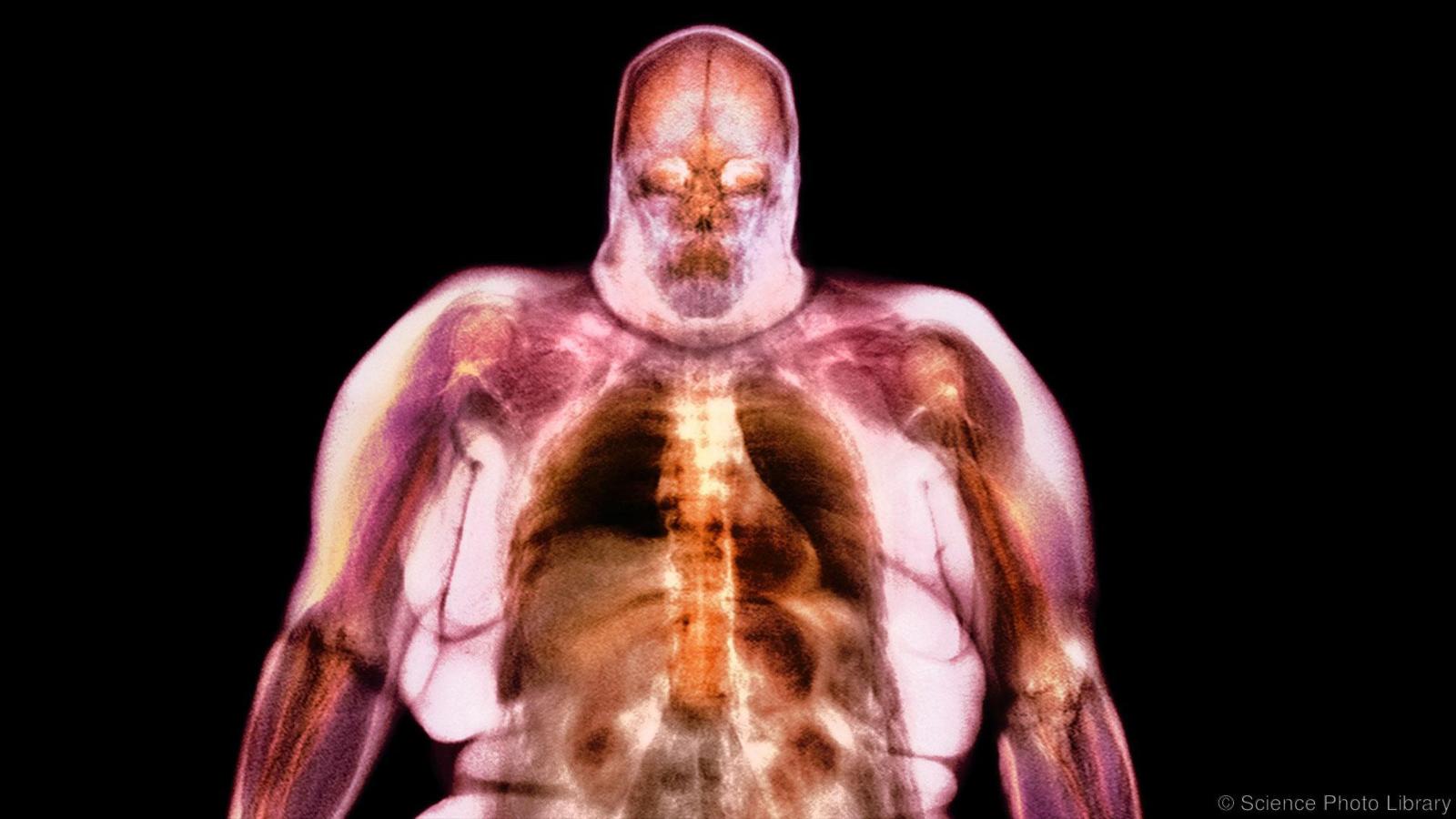
A new study published last month in The Lancet is the best evidence yet that besides causing and irritating asthma, heart attacks, strokes, dementia and autism, PM pollution can also trigger diabetes.
Using new statistical tools, it estimated that American air pollution caused 150,000 new cases of diabetes in 2016 alone. Worldwide, 8.2 million years of healthy life were lost to the disease by pollution.
Funded by the US Department of Veterans Affairs, and authored by VA doctors and others from the Saint Louis area, the study is the largest to ever examine the link between PM exposure and insulin resistance, the condition that often results in Type 2 diabetes in adults.
It used data from almost 2 million American veterans that were followed for eight and half years and matched with air quality data from NSA and EPA sources. The authors controlled for obesity and BMI, so it wasn’t the case that heavier people simply lived in more polluted neighborhoods and were also more likely to get diabetes. Rather, increased exposure to PM increased your likelihood of getting Type 2 diabetes.
There are many reasons why PM pollution is so harmful, but a big one is that it’s so very tiny and often contains toxic metals. Its small size allows it to not only penetrate deep into the lungs, but lo pass right through to the bloodstream. There, it circulates to different organs and causes inflammation. The inflammation increases insulin resistance. Eventually, this insulin resistance can become so severe the pancreas becomes unable to pump out enough insulin to compensate, and diabetes can set in.
Besides making the case for a link between PM pollution and diabetes, the study also confirms there appears to be no level of exposure to PM that isn’t capable of leaving a harmful mark. While EPA’s annual PM pollution threshold is 12 μg/m3, or micrograms per cubic meter of air, this VA study says the risk of diabetes starts as low as an 2.4 μg/m3 average per year That is, your risk of getting diabetes from air pollution begins at a level of exposure that’s almost 10 times less than the regulatory standard called “safe” by EPA.
In an Atlantic article reporting on the study, experts are quoted as saying the connection between PM2.5 and various health risks is now so clear that people should try to avoid large amounts of particulates, if they can.
“Live away from the major sources of emission. Don’t live right near the 405,” Dr Al-Aly, one of the authors stated, referring to the congested freeway in Los Angeles.
Tanya Alderete, who studies the connection between air pollution and disease at the University of Colorado at Boulder, says people should rethink biking and running in heavy traffic, “We shouldn’t be engaging in strenuous physical activity during rush hour or near major roadways,” she says.
The close association between PM pollution and Environmental Justice issues has been documented repeatedly, most recently by the EPA itself. African-Americans are more likely to be exposed to high levels of PM than other demographic groups. At the same time, African Americans are almost twice as likely to be diagnosed with diabetes as non-Hispanic whites. This is not a coincidence.
No other form of air pollution is linked to the wide variety of illness PM is now associated with in the scientific literature. The more it’s studied, the more PM becomes the most insidious form of air pollution we know about.
Dallas’ Office Of Environmental Quality: “You Can’t Handle the Truth” about Pollution

MONDAY, AUGUST 27th
9 AM
ROOM 6ES
DALLAS CITY HALL
CITY COUNCIL QUALITY OF LIFE COMMITTEE HEARING ON DALLAS JOINING A NEW REGIONAL AIR NETWORK
______________________________________________
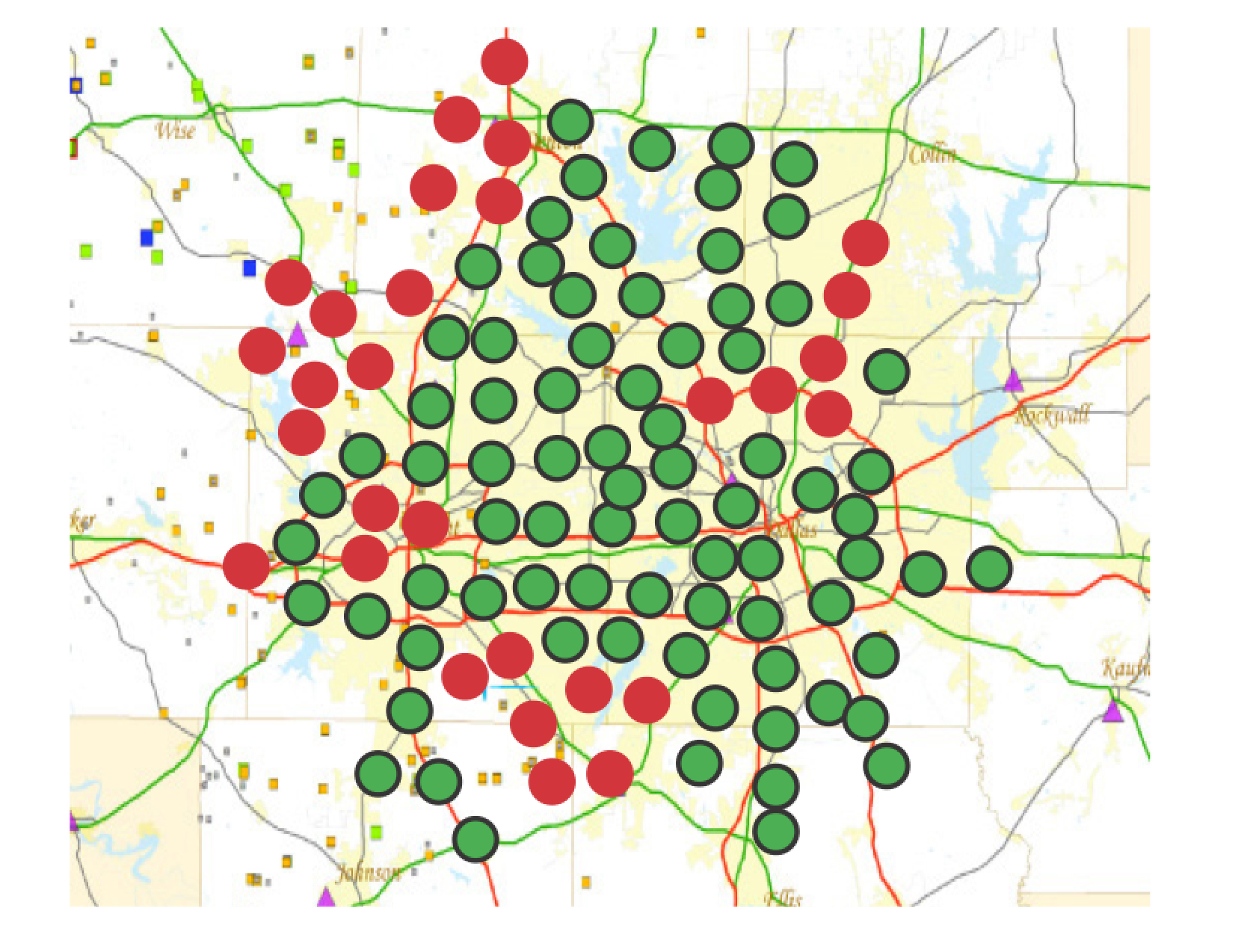 Over the last two years, as members of the DFW Air Research Consortium have promoted the idea of a dense grid of low-cost, high-tech air sensors spread across North Texas, their audiences have usually had one universal response: “This is great. It’s a no-brainer. When can we start? “
Over the last two years, as members of the DFW Air Research Consortium have promoted the idea of a dense grid of low-cost, high-tech air sensors spread across North Texas, their audiences have usually had one universal response: “This is great. It’s a no-brainer. When can we start? “
The single exception to this excitement is the City of Dallas Office of Environmental Quality.
Strange isn’t it? That hotbed of radical environmentalism known as Plano is embracing the idea of network air monitoring with both arms. Richardson and Fort Worth are interested as well.
But within Dallas City Hall there’s not only skepticism, but out right hostility to the the “smart city” idea of providing real time air quality information to citizens from hundreds of monitors.
Why?
On more than one occasion OEQ staff has said that they don’t want to have to take calls from Dallas residents who notice high air pollution levels in their neighborhoods and…expressed the opinion that “certain groups won’t responsibly use the information produced…like in Joppa.”
In other words, the public can’t handle the truth.
(Remind us again what happened in Joppa?

Oh yeah, Dallas OEQ staff was in favor of putting two additional dusty dirty batch plants in the small Freedman’s community that already has a large and polluting roofing shingles plant, a batch plant, and a huge rail switch yard surrounding it.
They made their recommendation for two more batch plants without doing any kind of air monitoring at all in Joppa, despite months of residents testifying at various hearings and meetings about the pollution problem and despite OEQ having the equipment to do it.
Staff made their recommendation without comparing the pollution in Joppa to other Dallas neighborhoods, or without examining any kinds of equity issues at all. Is Joppa the victim of Environmental Racism or not? The OEQ was silent.
Staff based their support solely on the lack of complaints – a record rendered invalid by plenty of Joppa community meetings where air pollution was complained about – and the moderate levels of pollution recorded by the single EPA-TCEQ PM monitor in all of Dallas County, located some nine miles away from Joppa near Mockingbird.
When Downwinders showed up a week before the Council vote and actually took air samples in Joppa for the first time, they showed levels of Particulate Matter that were much higher than that EPA monitor, demonstrating how ridiculous it was for OEQ to base its assurance to Joppa residents on it. It made them look like they hadn’t been doing their job. And they hadn’t. And they hadn’t done it in West Dallas with the concrete storage silo and batch plant fights there. Lately, OEQ hasn’t met a polluter it didn’t like.)
So instead of endorsing the idea that the public has as much of a Right-to-Know what’s in their air as in their food, OEQ would just rather you just not know. Ignorance is bliss.
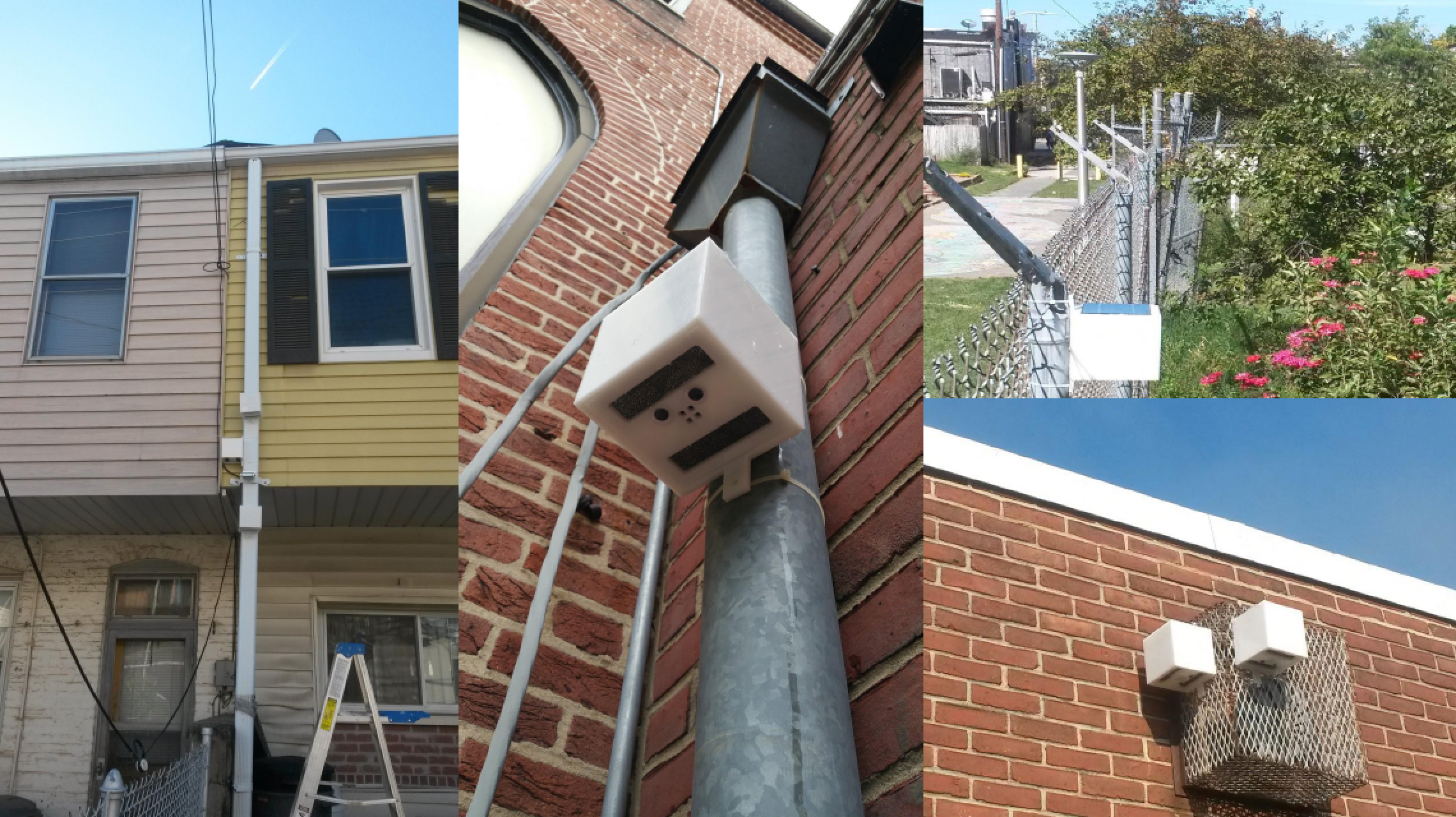 OEQ staffers also have said they object to a network of new air monitors because EPA doesn’t yet recognize their data as “official” and so it can’t be used for enforcement…yet. But do these air monitors have to have that official recognition to begin doing lots of good things for public health?
OEQ staffers also have said they object to a network of new air monitors because EPA doesn’t yet recognize their data as “official” and so it can’t be used for enforcement…yet. But do these air monitors have to have that official recognition to begin doing lots of good things for public health?
Joppa residents didn’t need EPA certification to compare the levels Downwinders recorded with the “official monitor” and know something was wrong. Doctors say they don’t need it to begin looking at correlations between area pollution levels and heart attacks, strokes ER visits, and school absenteeism. Cyclists and runners say they don’t need EPA certification to plot the least-polluted routes for exercising according to the grid. Cities like Plano says it doesn’t need it to better time traffic lights and reduce pollution that way.
It’s quite possible just knowing there are new monitors out there relaying real time information will now make a plant manager think twice about doing something questionable on a weekend or holiday. That’s enforcement – without EPA certification.
Given that Dallas currently doesn’t quantify or measure Environmental Justice issues in the city limits, a monitor network could provide planners and City Council members with a tool to do just that. It could graphically demonstrate how some Dallas neighborhoods are burdened with a lot more air polluters than others, and draw a map of those inequities to prevent them being made worse….to prevent mistakes like the OEQ staff was making in Joppa. You don’t need EPA certification for that impact either.
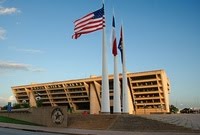
The hollowness of these staff arguments is proven by OEQ’s own actions. Even while it dismisses the unruly democracy of a real time broad-based PUBLIC monitor network, it’s committing over a million dollars of in-kind staff time and City resources to assisting a PRIVATE air monitoring study that is supposed to show how health can be improved….without EPA certification of the monitors being used.
So the same argument that city staff is using to dismiss the public network is the same one it’s using to support the private study.
You might recognize this M.O. at City Hall:
Staff decides it absolutely must do something about something. It decides how to accomplish that something after an exhaustive and rigorous search of talent and resources within a 100 foot radius of the office where that something is decided. An all out effort is then made to bias, slant, tilt, and otherwise favor the approach staff has decided must be taken against all other alternative approaches that might make sense outside of the 100-foot office radius. Nothing but the original staff approach is worthy of consideration, all others being the work of Satan or Dirty Hippies.
And the City Council? The Deciders for the public-at-large? They have an option to get involved at the very end of this sausage-making. Staff’s view seems to be that bliss is ignorance here too.
This happened with the Trinity River. Now it’s happening with air quality.
In 2014 Dallas got some Rockefeller Foundation money for “Resilience“ preparation. For those without a program, resilience is the fancy Rockefeller Foundation word for Climate Change, or rather the symptoms of climate change. Elected officials and bureaucrats are supposed to feel safer about using it.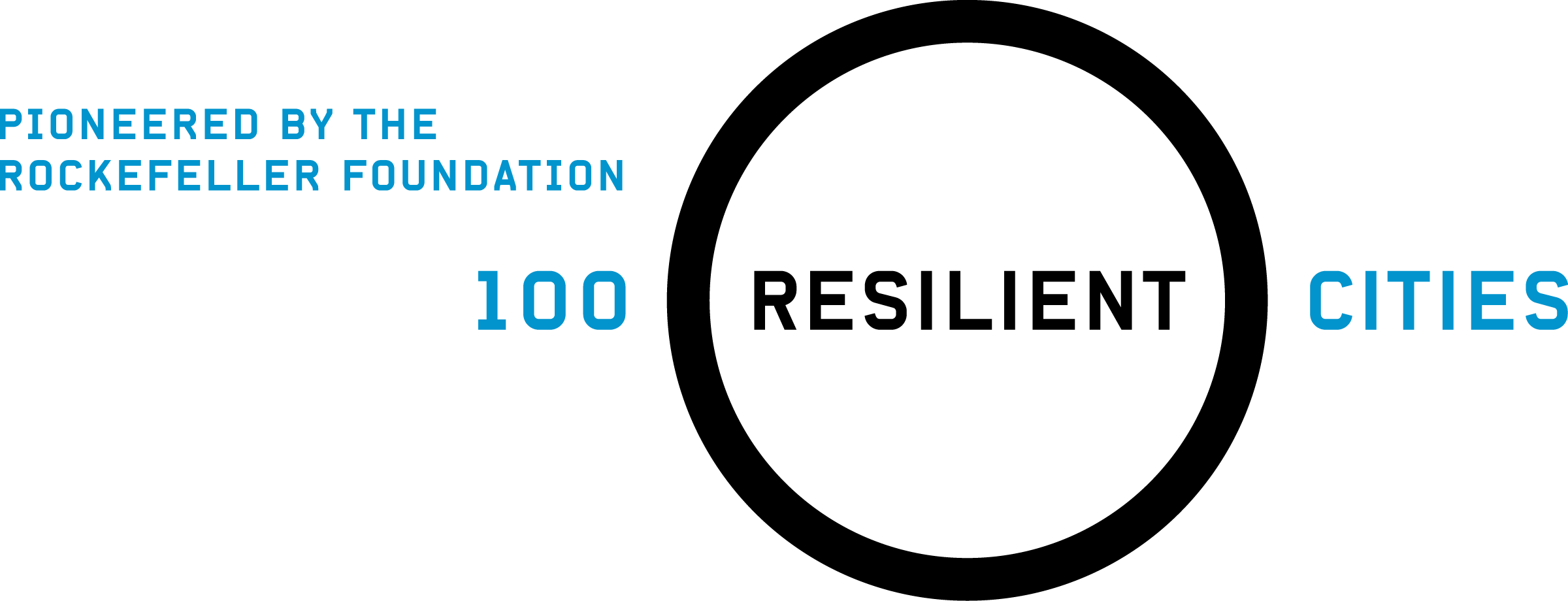
Dallas got so much money that the City created an Office of Resiliency. And that office sponsored invitation-only forums on how Dallas could be more resilient. Not open forums mind you. Not public hearings. They wanted the folks they’d located through that rigorous and exhaustive vetting process. None of the Satanists or Dirty Hippies got notice.
One of the right kind of groups that did get invited to those forums was the Texas Nature Conservancy, a mostly wealthy and white group of landowners dedicated to the noble idea of putting aside large tracts of undeveloped land for permanent preservation. It’s a group well-known for its dedication to open spaces – but not for any research it’s ever done on air quality.
Nevertheless, out of these forums suddenly emerged a partnership between the City of Dallas and The Nature Conservancy to do some kind of new air quality monitoring. There was no competition of concepts and no decision by the City Council. Staff had decided, and that was that.
And so you get the “Breathe Easy” Study.
Nine (as yet unspecified) DISD schools in “South Dallas” will be wired with new air monitors recording Ozone and Particulate Matter pollution in real time over one or two years to study the impact of anti-pollution measures like stricter idling policies on school absenteeism rates.
 But while the information will be gathered in real time from these nine schools, that information will not be shared with the public on the City of Dallas website until after (an as yet unspecified) time has passed. No annoying calls from pesky citizens (or parents) asking why their neighborhood’s air pollution levels are so high today.
But while the information will be gathered in real time from these nine schools, that information will not be shared with the public on the City of Dallas website until after (an as yet unspecified) time has passed. No annoying calls from pesky citizens (or parents) asking why their neighborhood’s air pollution levels are so high today.
Furthermore, after the study is completed it’s unclear what’s going to happen to the monitors in the nine schools.
In this case, the Conservancy and City seem to be tracking the “resiliency” of Dallas students in the face of chronic and acute air pollution problems, and then letting them know after the fact how resilient they were.
And is it irony, cynicism, or both when Dallas City Hall says this new study is needed because “Black kids in Dallas have an asthma rate eight times higher than Asian children and four times higher than whites.”
Maybe that’s because the Dallas OEQ keeps approving batch plants in their neighborhoods.
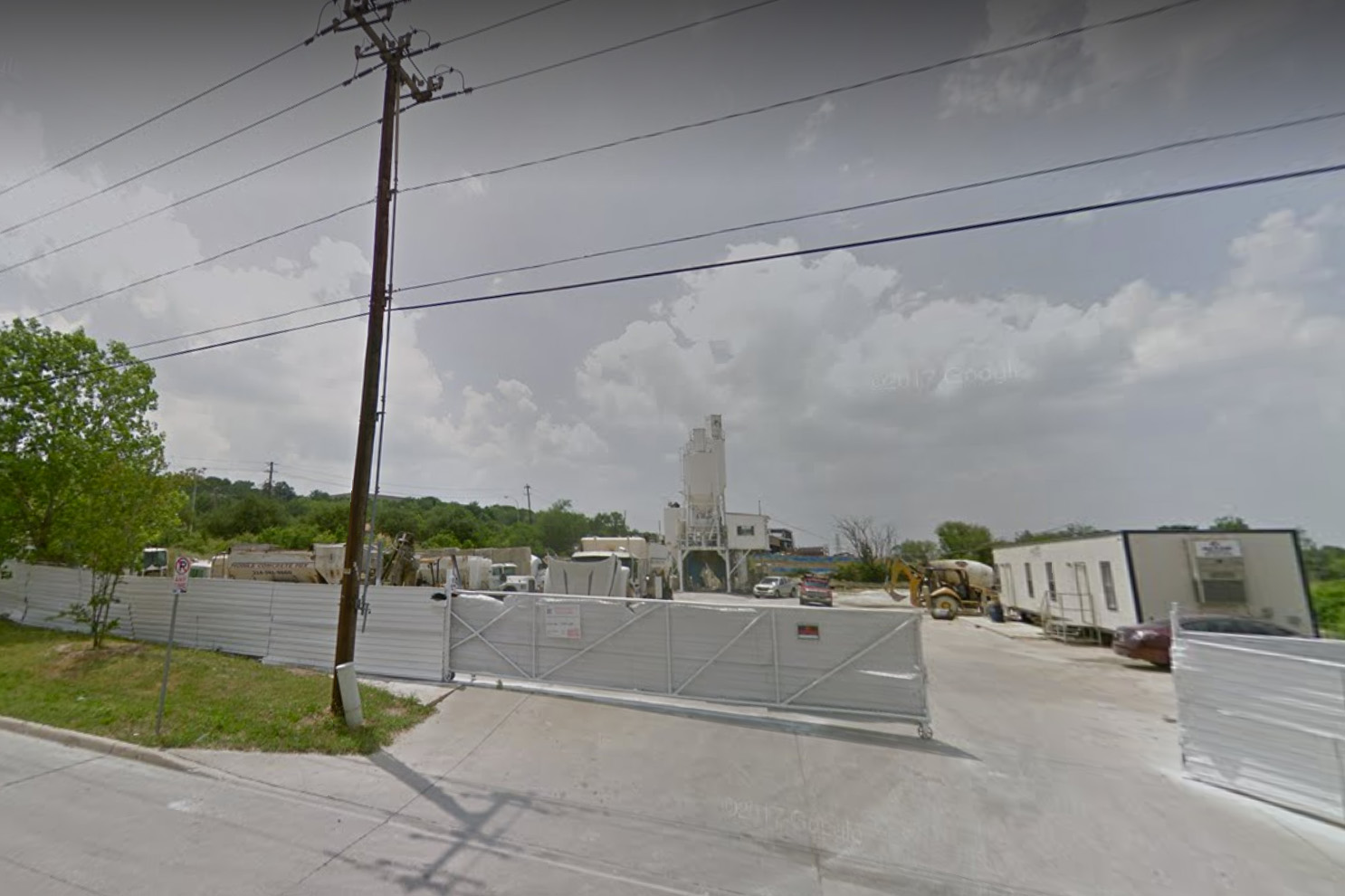 The same department which approved the relocation of the Argos batch plant from gentrified Trinity Groves to working class West Dallas, approved Buzzi’s 165-foot tall concrete silo next door, approved the RamCrete batch plant permit down the street, and whole-heartedly approved two new batch plant permits in Joppa IS NOW concerned about Environmental Justice issues! What amazing powers that Rockefeller money has.
The same department which approved the relocation of the Argos batch plant from gentrified Trinity Groves to working class West Dallas, approved Buzzi’s 165-foot tall concrete silo next door, approved the RamCrete batch plant permit down the street, and whole-heartedly approved two new batch plant permits in Joppa IS NOW concerned about Environmental Justice issues! What amazing powers that Rockefeller money has.
So far, TNC reports they’ve received almost $280,000 in grant money for support of this study. Paperwork found as part of a Texas Open Records Act Request Downwinders submitted to City Hall suggest the City is donating a million dollars in data services capacity alone. That’s in addition to the considerable staff time also lent to the effort. In-kind donations from DISD have not been disclosed.
We know that reducing kids’ exposure to PM pollution will help their health and well-being. We know one way to do that is by turning off vehicle exhaust. It’s not clear what kind of return the TNC or City is getting for its considerable investment.
Meanwhile, the idea of a new network of low-cost, high-tech monitors throughout North Texas giving the public real time information about the state of the air its breathing actually sounds like a great Rockefeller resiliency grant because it helps individuals and localities deal with the symptoms of climate change in their daily lives.
Moreover it’s an indigenous, grassroots effort.
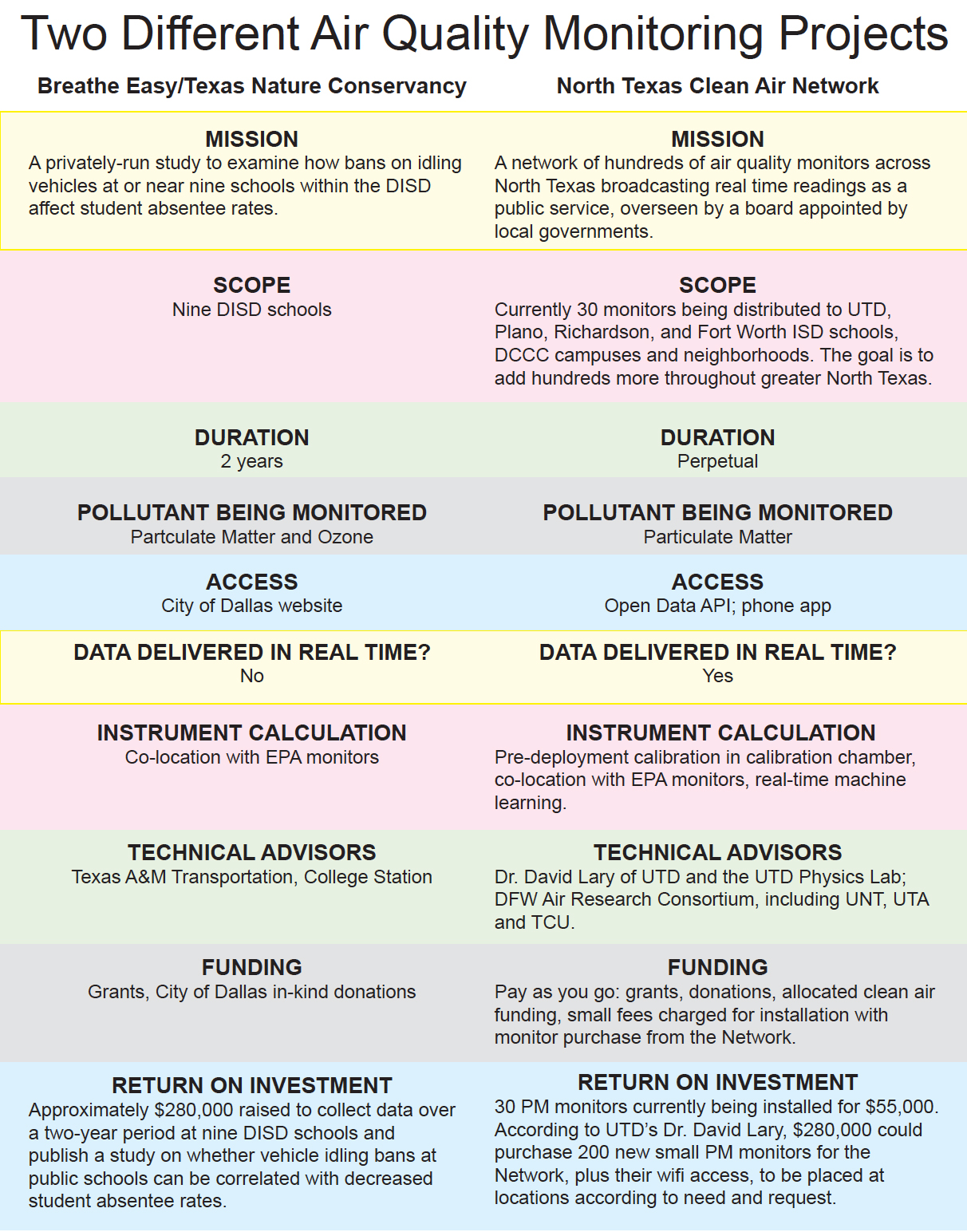
Because the rigorous and exhaustive vetting at City Hall didn’t make it the long 17 miles up to UTD, staff had no idea that one of the nation’s premiere experts in air monitoring teaches there. Oxford-trained Dr. David Lary just got a huge contract from the U.S. armed forces to help them better equip our soldiers for fighting in hostile and toxic urban environments. A big selling point was all the different air toxins in DFW standing in for the real thing. Honest.
It was Dr. Lary’s 2016 National Science Foundation proposal for a pilot project that got the regional network ball rolling. Even though it didn’t get funded, it brought together local governments, scientists, and citizens groups who then forged their own regional slow-cook version. Representatives from UNT, UTA, TCU, and UNT’s Health Science Center participated. So did Plano, and Dallas County.
Dr. Lary has outlined a monitoring network that’s capable of correcting itself in real time using those EPA official monitors as a baseline. EPA has said they’re interested in using his approach. So has NASA. He’s the foremost authority on this topic within hundreds and hundreds of miles but somehow, but Dallas city staff never found him because he wasn’t on that exclusive invite list.
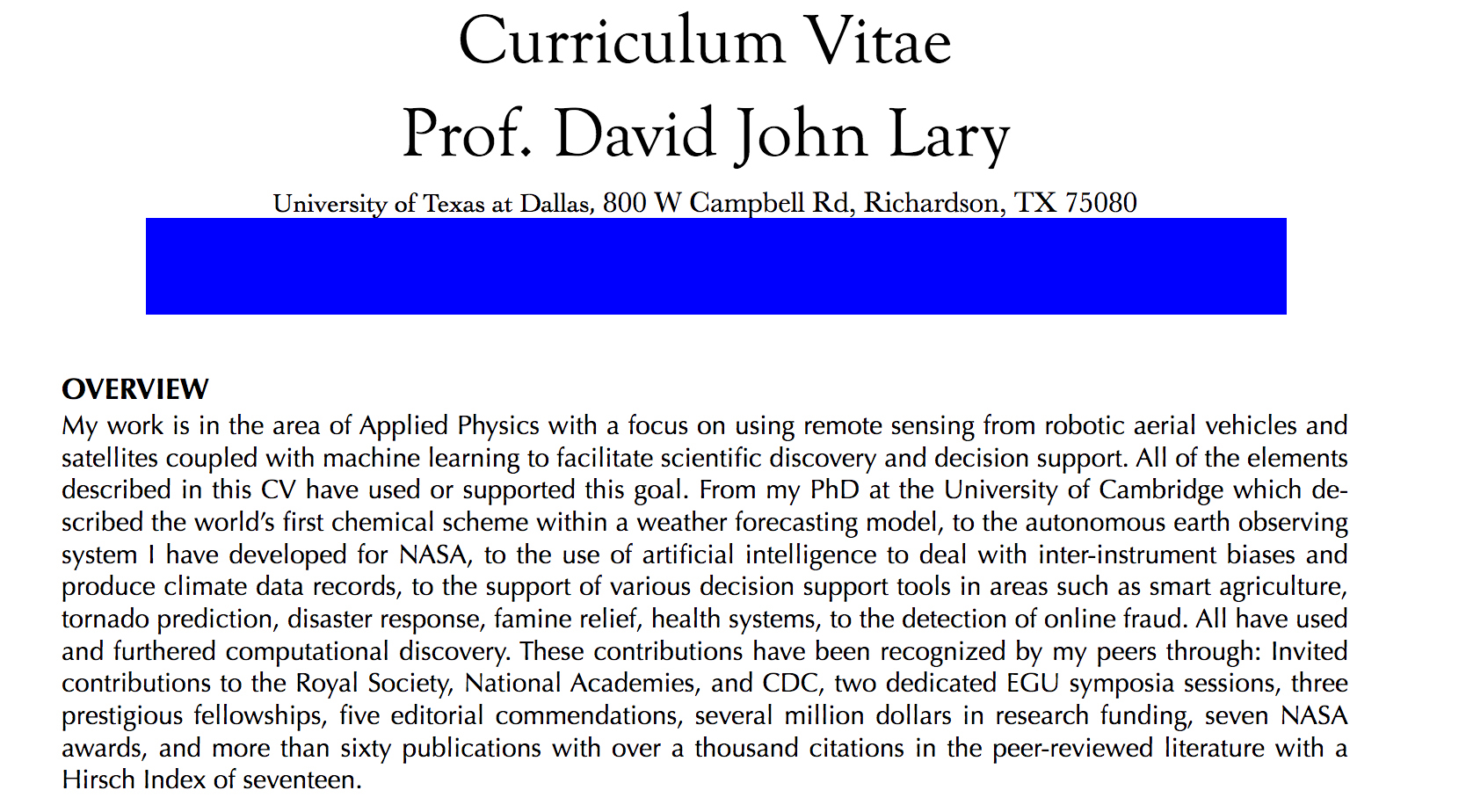 The TNC-Dallas Breathe Easy study is using the Texas A&M Transportation Institute for their air monitoring expertise. Much like the Nature Conservancy, this is a fine outfit, well-known for its work in transportation policy. It is not known for any air quality monitoring work and one can look in vain on its website for a mention of such. No one on their faculty even comes close to matching Dr. Lary’s credentials.
The TNC-Dallas Breathe Easy study is using the Texas A&M Transportation Institute for their air monitoring expertise. Much like the Nature Conservancy, this is a fine outfit, well-known for its work in transportation policy. It is not known for any air quality monitoring work and one can look in vain on its website for a mention of such. No one on their faculty even comes close to matching Dr. Lary’s credentials.
The kicker is that for the same $280,000 as Breathe Easy has raised, Dr. Lary has said he and his lab could build 200 + monitors for regional distribution. Data services will be donated by UTD. You get about 190 more monitors and real time public access for the same money.
So on the one hand you have an expensive study run by a private foundation for a short time using untested expertise, and on the other you have a cost-effective perpetual public network advised by one of the country’s leading authorities on air monitoring. You don’t have to have lived in Dallas very long to know which choice was the “no-brainer” for staff.
The Private Study and the Public Network don’t have to be mutually exclusive, but that’s the way City staff often portrays the choices to the Council – whose first exposure to any of this material will be at the scheduled August 27th Quality of Life Committee public hearing on joining the Regional Network, chaired by Council Member Sandy Greyson.
The Conservancy study could be done parallel to the establishment of the network and its school monitors folded into it at the end of the planned two-year shelf life. The city could help the Conservancy and be a part of the Network at the same time. But Staff seems to have made up their minds they can only support one air monitoring project, or rather, dug in their heels over the overly-democratic goals of this network project – it being supported by the Satanists and Dirty Hippies and all.
There’s no doubt that the same changes in technology which have disrupted other industries are disrupting environmental monitoring too. The ability to buy very reliable monitors for not much money is sending control away from top-down hierarchies to the bottom-up, crowd-sourcing rabble. A few expensive sites are being replaced by hundreds of inexpensive ones. Homeowners are already buying and installing their own consumer versions and linking to national and international networks. They’re making the status quo obsolete, one monitor at a time.
The regional network proposed by Dr. Lary and the DFW Air Research Consortium is designed to try to harness this disruption for public health’s sake. It’s open source, accepting all comers that meet its technical guidelines for participation, utilizes machine learning, and dispenses monitors where the science and need lead, no matter how many. It’s the same thing being done in Los Angeles, Baltimore, Chicago, and Chattanooga. And even Plano, which has already ordered its first monitors from UTD.
Plano has decided it wants a seat at the table as the sensor networks of the future are built. It’s participating out of self-interest because it knows otherwise, the city might not have a say in how the technology is used there. It’s the polar opposite from the sentiments Dallas OEQ staffers have expressed.
On the 27th, Council Member Greyson will be using her Committee hearing to contrast and compare the two air monitoring projects.
City staff will do one presentation on the Breathe Easy study and UTD’s Dr. Lary and Downwinders Director Jim Schermbeck will do another on the regional monitor network. 
Then it will up to the Committee to decide if Dallas can be as progressive on air quality as Plano.
We’re told there will be no public comment allowed. Still, we encourage you to come down to City Hall, put on a button, buy some popcorn, and root for Democracy. The Dirty Hippies are on a roll of late.
2018: Worst Smog in Five Years…and Ozone Season Isn’t Over
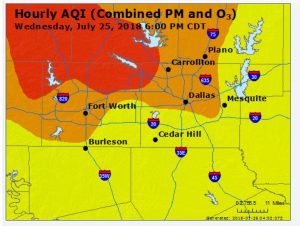
With months of “ozone season” still to come, 2018 is already one of the worst years of DFW smog pollution this decade.
As of August 9th, six out of the 20 North Texas ozone pollution monitors have registered at least four days when the average concentrations of smog were 80 parts per billion or higher over any eight-hour period. The current EPA ozone standard is 70 ppb over eight hours. Most scientists who study ozone pollution recommend between 60 and 65 ppb.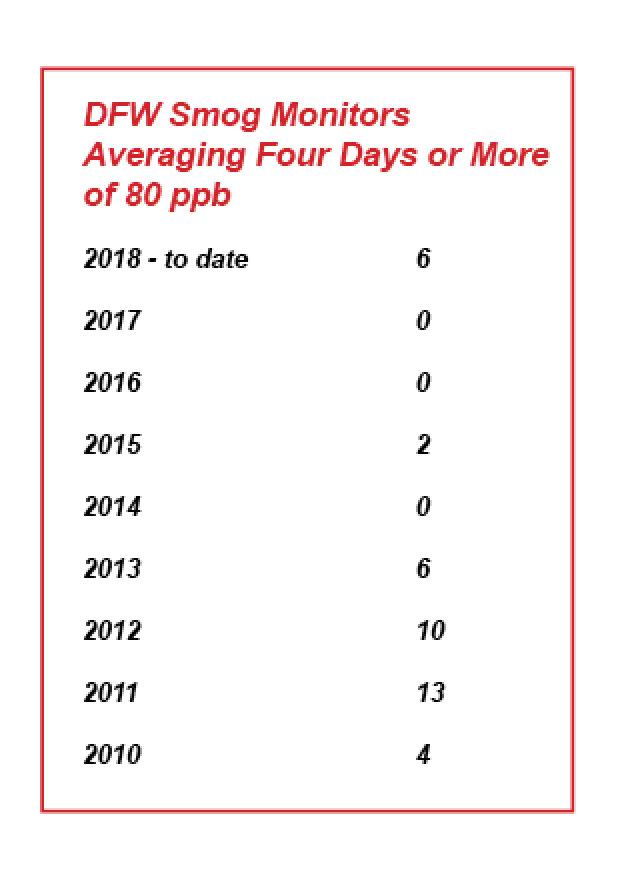
Unfortunately our lungs don’t breathe averages. Regulatory accounting smooths out the highs and lows. This summer has seen at least five sites record smog in the 90-95 ppb range for more than an hour. That’s very hazardous breathing.
There’s no question there were public health consequences to those extreme air pollution levels. Asthma attacks were triggered, COPD patients were gasping, but also strokes and heart attacks. We just don’t know how many…until after the fact.
It’s the first time in two years that any DFW monitors have had 8-hour averages of 80 ppb or above, and the first time since 2013 since there been at least six. In fact, this year’s total number of 80-or-above monitors is almost equal to the total number from the last five years combined.
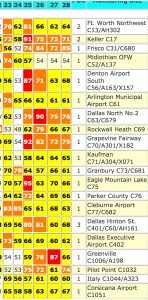
The last week of July was a bad one for DFW breathers.
Besides the number of high smog readings, the location of the monitors recording them should be of concern. Five out of the six registering the highest numbers this year have long histories of being among those registering the highest numbers in past years – Grapevine, Eagle Mountain Lake, Dallas Hinton, Dallas North and Frisco. Only Cleburne might be considered an outlier. The fact the same sites keep popping up over and over again means the strategies for reducing smog pollution aren’t working when put to the test like this July’s heat wave.
But of course that assumes there are any strategies for reducing smog in DFW. And technically there are. But they aren’t being vetted for their effectiveness, and they aren’t being enforced, and some are even being rolled back. After 27 years of continually violating the Clean Air Act for smog pollution, there’s nobody in any level of government working on a cogent plan to get DFW into compliance. Law and order rhetoric from Austin and Washington not withstanding.
What made July smog worse than usual was the heat. Climate scientists are telling us we’re going to be having more summers like 2018, not fewer. So this year’s levels are probably a precursor, not an aberration. But that’s a hard sell to elected officials whose campaign accounts depend on denying the science.
The punch line to this year’s sudden and dramatic spike in higher smog levels? It might still result in officials taking the Orwellian stand that the air in DFW is getting better. How is such a thing possible? Through the wonders of regulatory math.
EPA’s classification of how bad or good air quality is in any region is done by taking the 4th highest annual reading from each monitor and then keeping a rolling average of three years’ of those annual 4th highest numbers for each monitor. For this year, only the 4th highest numbers for 2016, 2017 and 2018 are included in the rolling average. Denton did see high numbers in 2015, but those are all now rolling off and not being counted.
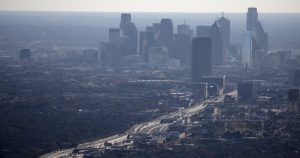
Up to now those 2015 numbers have kept the regional smog average in Denton at 81 ppb despite relatively light ozone seasons in 2016 and 2017. Now that that 2015 high number is rolling off, it would take the Denton site having 4 separate days of 90+ ppb smog in the next 90 days to make the average rise back up to 81 ppb. If that doesn’t occur, then the Denton average could drop to somewhere in the mid-to-upper 70 ppb range.
Should that happen, expect to see lots of regional back-slapping among officialdom for bringing down that Denton number and “continuing to make air quality progress.” Even as more monitor sites see higher smog numbers, officials will declare their anti-pollution measures are working splendidly. But that will not be the case, and you should not be misled.
While there might be a bit of specific progress made at the Denton monitor site, the increase in the number of other sites registering higher levels of smog they haven’t seen in years negates it. If all it takes is a heat wave to send two years of lower numbers down the drain, and the future is full of heat waves, then that’s not really progress, is it? We’re forced to put our fate in the hands of the weather instead of our own planning. Not very proactive, but that’s the state of air pollution control in DFW in 2018: “Please Dear God, keep it cool this summer.”
Even before the Trump Administration came into office the EPA wasn’t enforcing provisions of the Clean Air Act that DFW blew by ages ago – not correctly classifying its non-compliance, not requiring controls on major polluters, providing one extension after another. Now of course, there’s total abdication of even the pretense of striving toward cleaner air for its own sake.
Which is why if any progress is going to be made over the next 2-3 years, it must be made at the local level. No one else gives a damn. Officially.
THE CLEAN AIR FUND THAT TIME FORGOT
Over a decade ago $500,000 was collected from North Texas local governments to protect Texas air.
It’s been sitting in a bank account ever since. Until recently, not too many people even knew it existed.
Now, citizens want to use a part of it to build a world-class 21st-Century air monitoring network for DFW.
__________________________________________
In 2006, then-Dallas Mayor Laura Miller teamed up with Houston Mayor Bill White and organized a coalition of Texas local governments to oppose the “fast-track” permitting of a dozen new coal plants Governor Rick Perry was pushing.
15 North Texas cities, Houston, and McLennan County (Waco) established the “Texas Clean Air Cities Coalition” to fund a legal team and the technical expertise needed to take on not only the big utility companies, but Perry and the State of Texas as well.
But before the battles could begin, a settlement was reached that cancelled all but one of the coal plants. The approximately $500,000 raised by the Coalition to wage clean air war was not needed now. Instead of reimbursing the separate contributors, it was kept in total by the Coalition, possibly because it had already been budgeted to “protect Texas air.”
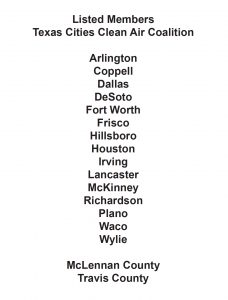
And there it’s sat ever since. With each new election cycle, the number of local elected officials who knew about the fund got smaller and smaller, until there was hardly any institutional memory of the Coalition or its half-million dollar fund left at all.
Downwinders only recently found about the money in the course of discussing funding of the new regional air quality monitoring network we’re working to establish with local policymakers.
While visiting with Dallas Council Member Scott Griggs about Dallas establishing such a network in partnership with Plano and Dallas County, CM Griggs mentioned the Texas Clean Air Cities Coalition and the $500,000 it had accrued, and asked us how our Network idea was different than the TCACC mission. We consider ourselves the premiere clean air watchdog group in DFW but we had no idea the Coalition or its fund was still around.
And, as it turns out, Griggs is the “Principal Officer” of the fund.
Needless to say, we were gobsmacked.
After reviewing some paperwork on the Coalition in Griggs’ office, we answered his question by suggesting that while the original goal of TCACC was to actively oppose those “fast-tracked” coal plant permits, the mission of the monitor network was to gather air quality information for public health purposes.
But on closer examination, we did notice similarities. Many of the municipalities that contributed to the Coalition fund are the same ones that are now interested in participating in the new monitor network, which like the Coalition, is a regional effort. The Mission of the Coalition is “to protect Texas air” primarily, but not exclusively through permit opposition. The spirit, if not the mechanics of the Coalition and Network are originating out of the same concern for public health.
That being said, extracting the money from the fund for modern use could be a convoluted affair. Despite the broad executive 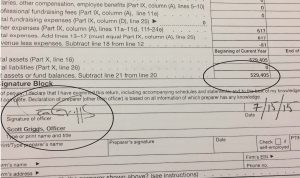 powers given to the Principal Officer in the Coalition’s by-laws, including the authority to commence litigation and intervene in permit proceedings, they don’t address air quality monitoring directly per se. It would appear to take a vote of the remaining Coalition members to ratify a new expenditure for the regional monitoring network, but it’s not clear who they are.
powers given to the Principal Officer in the Coalition’s by-laws, including the authority to commence litigation and intervene in permit proceedings, they don’t address air quality monitoring directly per se. It would appear to take a vote of the remaining Coalition members to ratify a new expenditure for the regional monitoring network, but it’s not clear who they are.
Of the five Coalition officer positions listed in the paperwork Downwinders received from Griggs, three would appear to be vacant, with no one representing Houston, Waco, or Irving due to retirements or elections. Only Griggs and Arlington City Council member Kathryn Wilemon, who both term out in May 2019, remain in elected office.
The discovery of the Coalition fund in 2018 raises all sorts of questions about why it didn’t get used over the last decade of air quality problems. Although there hasn’t been another tsunami of coal plants proposed, there’s still cement plant plants burning industrial waste, still oil and gas facilities still releasing way too much methane, still battles over batch plants in places like West Dallas and Joppa that the money could have gone to…but didn’t. Advocates like Downwinders didn’t even know about it to be able to make the case for its use. It’s a large policy failure on all fronts, that perhaps can be partially redeemed now by spending some of the the collected monies on another regional clean air initiative.
After learning of the Coalition fund, Downwinders asked Dr. David Lary of the University of Texas at Dallas Engineering Department to outline what kind of North Texas air monitoring network could be built with approximately HALF of the fund’s $530,000.
Dr. Lary is the author of the National Science Foundation grant that originally proposed the idea of grid air monitoring in DFW. He’s an expert in the field of high-tech low cost sensors and just got a large US Army contract for testing sensor equipment for the nation’s armed forces.
What he suggested was a 200 + sensor network, operating mostly on solar power and using wifi to bring real time air quality information to the regions seven million residents..for a low, low price of $280,000. This is his itemization:
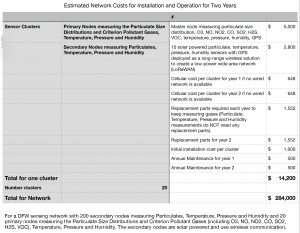
All previous plans had any regional monitoring network growing slowly by charging affordable fees for purchase and installation of sensors. If there’s a large clean air fund that could pay for the immediate build-out, it would propel DFW into the front ranks of “smart cities” and provide public health benefits much sooner.
Now that a City Council Quality of Life Committee hearing has been set for Dallas to decide whether to join the monitor network, the opportunities the fund could provide deserve overdue attention. The question of what role the fund can or should play in paying for a new regional clean air network will be important. Having squandered the ability to provide the kind of assistance it was created for over a decade ago, let’s hope current officials don’t make the same mistake and ignore public health…again.
Dallas City Council Committee Sets August 27th Hearing on Joining New Regional Air Quality Monitoring Network
WE NEED YOU
TO SPEAK OUT….
FOR CLEAN AIR!….
FOR PUBLIC HEALTH!….
FOR ENVIRONMENTAL JUSTICE!…..
FOR SCIENCE!
MONDAY, AUGUST 27th
9 AM
ROOM 6 ES
DALLAS CITY HALL
1500 MARILLA
DALLAS CITY COUNCIL
QUALITY OF LIFE COMMITTEE
PUBLIC HEARING:
Should Dallas join Dallas County and Plano in establishing a new regional air quality monitoring network
Share the FaceBook Event Page 
Dallas residents’ Right-to-Know what’s in the air they’re breathing could take a big step on Monday, August 27th.
That’s when the Dallas City Council’s Quality of Life Committee will hold a public hearing to decide if the City should join a new regional air quality monitoring network. It’s the most important decision concerning Dallas city-wide air quality in years.
Why? Because information is power.
Despite the fact you breath lots more air than you eat food or drink water, product labeling allows you to know more about what you’re putting in your stomach than what you’re putting in your lungs. A 21st-Century air monitoring network would begin to correct that imbalance.
Unlike the current handful of monitors operated by the Texas Commission on Environmental Quality (TCEQ) and EPA, this new local network would have hundreds of small high-tech, low-cost sensors and they’d be reporting their information in real time on a phone-accessible app.
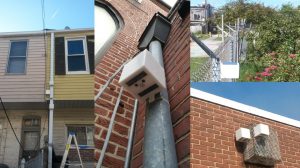 Despite being the home to 2.5 million people, and covering an area slightly smaller than the state of Rhode Island, Dallas County has only a single official monitor for deadly Particulate Matter pollution you can access online. Unless you live within close proximity of that one monitor you don’t have much idea of what kind of crap you’re inhaling.
Despite being the home to 2.5 million people, and covering an area slightly smaller than the state of Rhode Island, Dallas County has only a single official monitor for deadly Particulate Matter pollution you can access online. Unless you live within close proximity of that one monitor you don’t have much idea of what kind of crap you’re inhaling.
Being able to access real time air quality information no matter where you in DFW are has the potential to transform personal habits and public policy.
Residents with asthma or other breathing problems will have a much better picture of the air they’re actually being exposed to, down to the specific neighborhood or even street block. They can pro-actively plot a path to avoid polluted parts of town, or wait to take that walk or run.
Hotspots of pollution will be more readily identified by the people most affected by them. And, if we organize, that means they’ll get more notice from policymakers too.
Public health officials will be able to track school absentee rates with “bad air days.” City traffic engineers can time stoplights to reduce vehicle pollution. We’ll know which neighborhoods already experience a lot of air pollution and shouldn’t be candidates for siting new industrial facilities.
This is why the Dallas City Hall IT staff not only included high tech air quality monitoring in the category of “Public Health and Safety” but also “Equity and Empowerment.” This network and the information it provides can be a powerful tool for citizens.
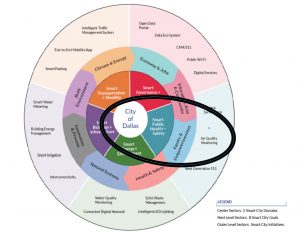
There are many ramifications to having this information available – some obvious, some we can’t imagine yet. High-tech air quality monitoring is one of the most useful applications of emerging “smart cities” technology.
Chicago is installing a grid of over 500 air quality sensors. Baltimore is doing the same. LA is committed to at least 100. Even Chattanooga, Tennessee has its own network. Now DFW, home to some of the worst air in the country for decades, has a chance to do the same.
Dallas’ Quality of Life Committee is Chaired by three-term council veteran Sandy Greyson, and includes rumored Mayoral candidate Scott Griggs, Mark Clayton, Omar Narvaez, Jennifer Staubach-Gates, Adam McGough, and Ricky Callahan.
If the Committee votes to join the Network, it’s recommendations would then be forwarded to the the entire 15-member City Council for formal approval.
As proposed, The North Texas Clean Air Network would be administered by a board that includes public health experts from Parkland and the Dallas County Medical Society, officials from every city, county, hospital or school district that become members and public interest advocates. This board would decide where to put new monitors, insure their technical proficiency, and help educate the public about the network.
Officially, it’s chartered goals are to
1. Provide the best, most up-to-date factual information about local air quality by supervising the implementation and maintenance of a publicly accessible, secure, and scientifically credible regional air sensor network providing simultaneous real time air quality information from multiple locations within member or contracted jurisdictions via the World Wide Web.
2. Provide fact-based public education resources on local air quality.
3. Support scientific research on local air quality by local colleges, universities, hospitals and schools.
4. Work with regulatory agencies and entities to further local clean air goals.
The Network began as a National Science Foundation grant proposal led by Dr. David Lary of UTD. It requested funding for dense concentrations of monitors in Plano and Southeast Fort Worth. It got a rare call back by the NSF, but no money.
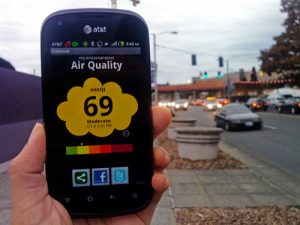 Still committed to the idea, the NSF grant partners then began building the same kind of monitor network across DFW using donations of resources and labor.
Still committed to the idea, the NSF grant partners then began building the same kind of monitor network across DFW using donations of resources and labor.
Over the past year, 30 Particulate Matter monitors have been bought or donated for this purpose. They’re being installed at community colleges, public schools, and one is being located in the Joppa neighborhood of Dallas. Consortium members now want to turn these monitors over to the proposed Network board so the system can be operated in the public interest as a kind of public utility.
There are no additional costs for the first wave of 30 monitors other than internet connectivity and minimal maintenance. More monitors can be added to the network by collecting fees for installation and using a portion for maintenance.
But as of last month, there’s an exciting new source of funding for the Network – an untapped regional clean air fund that over a dozen North Texas cities contributed to a decade ago and has sat unused ever since. Over $500,000 in local money has already been raised and budgeted to “protect Texas air.”
UTD’s Dr. Lary has proposed using slightly more than half of that collected money to build a sophisticated 200-sensor air quality network spanning across DFW measuring Particulate Matter pollution, temperature, pressure and humidity with an additional 20 primary monitors measuring the Particulate Size Distributions and Criterion Pollutant Gases (including O3, NO, NO2, CO, SO2,H2S, VOC), Temperature, Pressure and Humidity. The smaller 200 monitors are all solar-powered and use wifi.

Dallas has a reputation for desperately wanting to be known as “world-class” and a recent Morning News article noted how Dallas had a “high-tech image problem” among innovators. A 200-monitor high-tech air quality network would instantly propel the city into the ranks of the “smartest” wired metro areas in the US, not to mention advance the cause of local public health. Dallas could be ahead of the curve instead of behind it.
2018 is the 27th straight year Dallas and all of DFW will be in violation of the Clean Air Act. The State of Texas and the EPA have shown themselves to be unwilling to take the problem of dirty air seriously. Now its local government’s turn.
SHOW-UP ON MONDAY AUGUST 27th AT DALLAS CITY HALL AND SPEAK OUT FOR A PRO-ACTIVE RESPONSE TO DFW AIR POLLUTION PROBLEMS.
Historic: Texas’ First Citizens’ Smog Monitor Begins Operation in Wise County
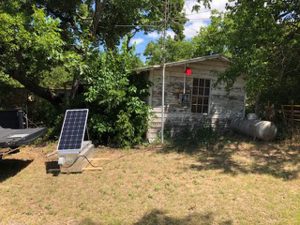
After a few technological hiccups, the state’s first permanent smog monitor built and operated by a citizens’ group is up and running in rural Southeast Wise County. And by the looks of this summer’s ozone season, just in the nick of time.

Conceived, designed, and supervised entirely by environmental scientist and UNT doctoral candidate Kari Northeim on behalf of Downwinders, the Atlas Monitoring Station is a first-of-its-kind adaptation of smaller, less expensive technology to perform the job of monitors many times its size and cost. It instantly becomes a huge milestone in our efforts to build a better system of air quality monitoring in North Texas.
The Atlas Station is a product of Downwinders’ Wise County Ozone Project, financed by a grant from Patagonia and an EarthTank prize won by Downwinders at EarthDay Texas in 2016. It’s objective is to collect continuous readings of Ozone, otherwise known as smog, in Wise County – until this week the only one of ten DFW “non-attainment” counties with no ozone monitors.
 Besides being downwind of much of DFW’s smog, Wise County is the birthplace of modern “fracking” and blistered with gas patch facilities that produce significant amounts of smog-causing air pollution. However, the nearest official smog monitors are approximately 30 miles to the east in Denton County and 20 miles south in Tarrant County. Despite past state and private computer modeling predicting smog to be worse in Wise County than the rest of North Texas when “ozone season” winds are out of the south-southeast, there’s been no monitor there to test that hypothesis. Until now.
Besides being downwind of much of DFW’s smog, Wise County is the birthplace of modern “fracking” and blistered with gas patch facilities that produce significant amounts of smog-causing air pollution. However, the nearest official smog monitors are approximately 30 miles to the east in Denton County and 20 miles south in Tarrant County. Despite past state and private computer modeling predicting smog to be worse in Wise County than the rest of North Texas when “ozone season” winds are out of the south-southeast, there’s been no monitor there to test that hypothesis. Until now. 
Accurate regional ozone readings are important to DFW because they determine how much in or out of compliance with the Clean Air Act we are. If smog levels being recorded by EPA monitors in their current locations aren’t reflective of higher smog levels actually being breathed in North Texas, then we need to know that and add more protective air pollution measures.
Last spring Downwinders bought two portable smog monitors the size of cable boxes from Colorado’s 2B Technologies at $5000 each. That’s a huge drop in price and size. Traditional EPA monitors doing the same job can cost hundreds of thousands of dollars and take up a quarter acre.
 2B factory-calibrates the monitors and they’re already certified by EPA, but from from June 2017 to March 2018, they were subject to additional testing by Kari at the University of North Texas (UNT) Engineering Lab.
2B factory-calibrates the monitors and they’re already certified by EPA, but from from June 2017 to March 2018, they were subject to additional testing by Kari at the University of North Texas (UNT) Engineering Lab.
Although small, these are incredibly reliable machines with an accuracy of greater than 1.5 parts per billion by volume, or 2% of the total reading. They measure ozone every ten seconds and can automatically average over a minute, 10 minute, or hour interval (like the state monitors do so we can compare apples to apples).
Small, portable, cheaper, but the monitors still need electricity. In order to have more siting options in a mostly rural county, the Atlas uses a 100 W solar panel to connect the monitors to the juice they need to take readings. Batteries provide back-up. This makes is a completely stand alone, self-sufficient monitoring station that we can put anywhere with a good south view.
Air is collected through a funnel and shuttled down a pipe that brings it into a weather-protected box where the monitor itself sits. 
During the Wise County Ozone Project, one monitor at a time will be deployed for a period of 3-6 months. Unfortunately, there’s not a way yet to get real time access to the monitor via the internet, so instead data will be downloaded by Kari every month and compared to readings at those Denton and Tarrant County monitors. Not perfect, but better than no monitor at all.
According to Northeim, who expects to be able to mine several scientific papers with the data she collects, “This research is critically important to develop an understanding of the true ozone exposure in Wise County. It’s very exciting.”
____________________________________________
Putting a Smog Monitor
Where No Smog Monitor Has Gone Before
EPA has 20 ozone, or smog, monitors in North Texas. Approximately half of those are considered “background” monitors on the edge of the denser urban areas. Originally the DFW “non-attainment area” for smog was only Dallas and Tarrant Counties. As the area’s populations grew, so did its air pollution problem and Denton, and Collin Counties were added, then Johnson, Parker, Rockwall, and Kaufman. Citizens petitioned and sued to bring Ellis And Wise Counties into the fold. All of these counties except Wise have an EPA smog monitor, despite Wise County being included in the non-attainment area since 2012, and despite state and private computer air modeling showing the County could have some of the region’s worst smog.
It’s Only June But DFW Is Already in Violation of the National Smog Standard
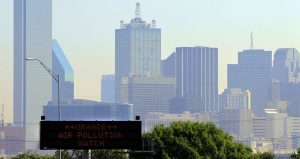 The early start to 100° + days in DFW this spring has meant an early start to high smog levels as well.
The early start to 100° + days in DFW this spring has meant an early start to high smog levels as well.
Although it’s not even summer yet, five official EPA ozone monitoring sites in North Texas have already recorded “4th highest” 8-hour ozone averages that put DFW above the 70 parts per billion federal standard for 2018: Grapevine 73 ppb, Keller 72 ppb, Dallas North (by I-635) 73 ppb, Dallas Hinton (Stemmons Freeway and Mockingbird) 72 ppb, and Denton Airport 72 ppb.
No matter what happens the rest of this 2018 “Ozone Season,” these numbers insure DFW will still be violating the Clean Air Act for a 27th year in a row.
Grapevine and Eagle Mountain Lake monitors have recorded the single highest 8-hour ozone levels in the state so far, at 89 and 92 ppb respectively.
Breathers will have to wait longer to find out how this year’s dosage will affect the all-important regional average, driven recently by the results from the Denton Airport monitor. The regional average is the highest 8-hour average number from any one monitor after averaging the 4th-highest ozone readings from each of the last three years. Extremely high years can be off-set by better years, or visa versa.
Slowly, the DFW regional ozone average has come down from the really bad old days of the 1990’s and early-Oughts. But for the last seven or so years, it’s plateaued in the 80-85 ppb range. As of 2017, Denton had a three-year, regional-leading average of 81 ppb.
Many observers believe the recent stagnation in the decrease of DFW smog is due to increased emissions generated by the Barnett Shale gas play taking up the slack from decreases from other large sources like kilns or cars.
A 2015 UNT study using the State’s own air modeling demonstrated the disproportional impact gas industry sources like compressors had on the area’s historically worst performing monitors in Northwest Tarrant County and Denton, accounting for up to 3 ppb of smog.
Closure or mothballing of three large East Texas coal plants will help keep the numbers down this summer from what they could have been, but it may not be enough to outweigh the impact of continued growth and reluctance by authorities to crack down on other large sources like the gas industry or the Midlothian cement plants.
And this summer’s early smog crisis is yet another reminder about why a 21st Century locally-controlled monitoring system is needed. During this last stretch of 100° + heat, when ozone levels were often climbing by 10 ppb or more per hour, the official EPA/State monitors were up to 2 and a half hours late. At 1 pm, a resident was still looking at 10 am data that was obsolete.
If the federal and state governments won’t do anything but make it more difficult to solve our chronic smog problem, it’s self-defense for local governments to at least be able to warn residents about how bad the air is in real time and at a location near them instead of the other side of town.
Joppa Benefit Shows What a New Dallas Black-Green Alliance Could Look Like
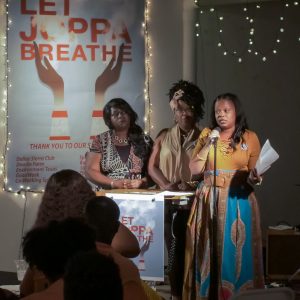
L to R: Jabrille McDuffie, Natasha Dunn and Temeckia Derrough of the Joppa Freedman’s Town Association
We raised another $3600 for air monitoring in Joppa amidst the most diverse “environmental” Big D event many could ever remember, with a program that won rave reviews from an overflow crowd. If you squinted, you could see the future. Thanks.
By almost any measure, the May 22nd benefit for air monitoring in Joppa fit the definition of success.
Packed crowd. Check
Engaging Program. Check
Moneymaker. Check
Political Game Changer…..Depends on what happens next.
As important as having a full house…was WHO was in the house. Here was a table of 10th Street Historic Neighborhood Association members, there was a table of Sierra Club members. Frazier Revitalization members sat next to Dallas Green Alliance leadership. For every green group represented there was a South Dallas neighborhood group also present and accounted for.
Not only was the event a success for Joppa, it has the potential to inaugurate a new era of cooperation between green and black groups in Dallas. One of the last orders of business were members of the Joppa Freedman’s Town Association reading a long list of needed reforms to be included in what they called the “Joppa Environmental Preservation District” that could be a model for other historically distressed Dallas neighborhoods. What started in Joppa could end up traveling to West Dallas, Pleasant Grove and Cedar Crest.

It was clear from the start this wasn’t going to be a staid program of speakers and performers. After about 30 minutes of eating, drinking, and mixing in the industrial chic of the GoodWork co-working space Downwinders now calls home, a booming ten-member section of the Sticks Mania professional drum line marched down Good-Latimer and directly into the event space. For the next 20 minutes, a sizable portion of a crowd at a Dallas environmental event could be seen sliding into outright twerking behavior, a probable first. You can see a video sample of Sticks Mania’s performance on our Facebook page here.
And you can see a gallery of highlights from the benefit on our website here courtesy of Norman J Jones.
Dallas’ own spoke word artist Rage Almighty did a great job of playing ringmaster for the evening’s progressive variety show as well as wowing the audience with his own verbal gymnastics and gyrations through the English language and race politics.
District 7 Council Member Keven Felder showed-up to give a rousing welcome and rally his constituents to be on guard for the re-submittal of batch plant permits by Martin Marietta. He also promised he was working on bringing cleaner industries to District 7 and Joppa.
 Keith Price and Douglas Carter performed two dramatic monologues from “The Freedmens” fresh off its run at the Wylie Theater downtown. They
Keith Price and Douglas Carter performed two dramatic monologues from “The Freedmens” fresh off its run at the Wylie Theater downtown. They
received a standing ovation at the end, and it was the first of many times during the night the audience could be seen dabbing their eyes.
Solakio Music provided the right mix of laid back soul and jazz that buffered the different segments and set the mood for whatever was coming next.
Comic relief and some added inspiration was added by the staging of a brief 2018 graduation ceremony for this year’s Downwinders’ College of Constructive Hell-Raising class. Almost a dozen new activists now “think more like organizers” after a ten-session, five month long course in affecting change. Each got a diploma from College “Dean” Jim Schermbeck and faithfully recited the school pledge to protect people and planet.
This year’s graduates heard their convocation speaker, civil rights legend Peter Johnson, talk about all the similarities between the fight against segregation in the 1960’s and the fight for environmental justice in places like Joppa today. Then they heard Dallas singer Vicki Larkin-Tovar belt out “Keeper of the Flame” as the class song:
“I’m the keeper of the flame
The teller of the story
For the ones that came before me
For the little pilot lights waiting to ignite
Like fireflies in the rain
Keeper of the flame”
 After that it was Joppa’s turn to speak. Temeckia Derrough, Natasha Dunn, and Jabrille McDuffie from the Joppa Freedman’s Town Association gave effusive thanks to the crowd for their support and laid out the elements for “what environmental justice in Joppa would look like.” Ms. Dunn brought many to tears in describing the group’s struggle to organize itself and remain steadfast in the face of so much pressure to stop opposing the new batch plants.
After that it was Joppa’s turn to speak. Temeckia Derrough, Natasha Dunn, and Jabrille McDuffie from the Joppa Freedman’s Town Association gave effusive thanks to the crowd for their support and laid out the elements for “what environmental justice in Joppa would look like.” Ms. Dunn brought many to tears in describing the group’s struggle to organize itself and remain steadfast in the face of so much pressure to stop opposing the new batch plants.
Among the changes sought by the residents are a switch to electric locomotives in the 100 plus year-old Union Pacific rail yard, more and better pollution controls on the industry surrounding them, buffer zones separating people from polluters, and new zoning and enforcement provisions that will help them start to reverse decades of environmental racism.
Time and again the JFTA leadership reminded everyone they’ll need all the help they can get if they hope to see any of these reforms materialize. Downwinders and the Sierra Club have both committed resources to the community. That list of partners needs to get longer. In signing-on to help build a Joppa “Environmental Preservation District” Green Dallasites have an opportunity to take a big step in addressing our own historical blindspots as a local movement. Stay tuned as we try to make it easier for groups and individuals outside the neighborhood to provide support.
Meanwhile, thanks to the big crowd, a silent auction, bartender tips, and some sizable donations from the Sierra Club and Frazier Revitalization, $3600 was raised for the purpose of buying air quality monitors for Joppa. We’re combining that with the $1600 already collected, for a grand total of $5200.
Thanks to everyone who contributed, whether it was $25 or $250. To see what your money will be buying for Joppa keep reading…..
What Now?
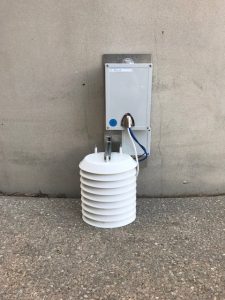
1. This monitor was built by the University of Texas at Dallas. It measures Ozone (smog) and Particulate Matter pollution. It’s already been picked-up and will be installed in Joppa in the next 30-45 days. It’s one of ten being placed around the region as part of a fledgling new air quality network. The public will be able to access its data online.
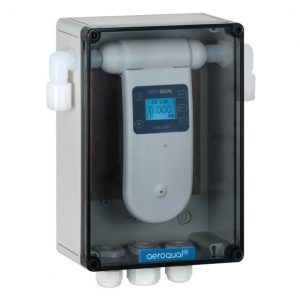 2. An Aeroqual portable Particulate Matter monitor like the ones Downwinders has already deployed inJoppa will be purchased with a protective case for use as both a mobile and stationary monitor in the community. While it records in real time, its collected data must be downloaded later.
2. An Aeroqual portable Particulate Matter monitor like the ones Downwinders has already deployed inJoppa will be purchased with a protective case for use as both a mobile and stationary monitor in the community. While it records in real time, its collected data must be downloaded later.
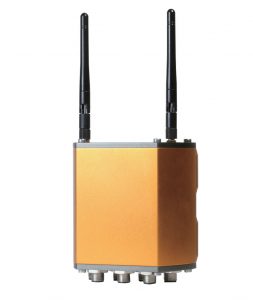 3. Beginning in the fall, five small Particulate Matter monitors will be built by UTD for distribution in a grid in Joppa. They’ll be connected to the internet by a wifi nodule which will make the data available to the public in real time. This will be a pilot test for a larger regional grid network being built by a consortium of universities and municipalities.
3. Beginning in the fall, five small Particulate Matter monitors will be built by UTD for distribution in a grid in Joppa. They’ll be connected to the internet by a wifi nodule which will make the data available to the public in real time. This will be a pilot test for a larger regional grid network being built by a consortium of universities and municipalities.
In total, by the end of the year, we plan on having seven PM monitors up and running in Joppa. Dallas County currently has one. At that point the neighborhood will be among the most “wired for air” communities in the nation. But it’s only a start to addressing the environmental racism that’s impacted Joppa residents for generations.


